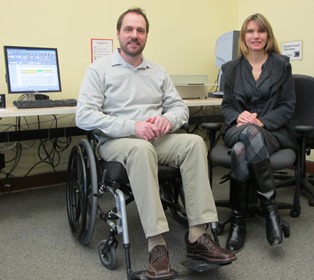Accessibility team works to create positive change
January 28, 2013
Share
 Andrew Ashby, Adaptive Technologies Specialist, and Michele Chittenden, Coordinator of Library Services for Students with Disabilities, both work in the Adaptive Technology Centre in Stauffer Library.
Andrew Ashby, Adaptive Technologies Specialist, and Michele Chittenden, Coordinator of Library Services for Students with Disabilities, both work in the Adaptive Technology Centre in Stauffer Library. At the Adaptive Technology Centre (ATC) – a resource and study centre for students with disabilities in Stauffer Library – Andrew Ashby keeps his door open to the student work space and rest area. As an adaptive technologies specialist, he is there to answer questions on the technological resources available. But his support extends way beyond the practical.
“Students like to have their own quiet space and the ATC is a place that can help them overcome many barriers,” says Mr. Ashby, who has a neurological condition and uses a wheelchair. “I try to bring my personal experience into my work as best I can. I think the most helpful thing for students who come in here is to learn that they are not alone.”
The ATC is a safe, welcoming space with staff available to help find the appropriate supports – such as mobile apps, software that can read textbooks aloud, and a transcription service that provides textbooks in alternate formats such as e-text, large print or Braille. It’s also located in the heart of the university, on the first floor of Stauffer, where students using the ATC can feel included in Queen’s daily life.
Integral to accessibility at Queen’s, the ATC is part of a larger plan to address accessibility needs on campus. Several working groups have been convened to help the university meet and go beyond the obligations set out by the Access for Ontarians with Disabilities Act (AODA). One of those groups is tasked with providing an overarching accessibility policy that clearly articulates the university's commitment to creating an inclusive campus community.
“We all have a role to play in integrating accessibility into our everyday lives. Policies provide the framework under which the university and its members operate,” says Julie Mekarski, Director, Client Services, Human Resources, and lead of the customer service working group. “Ensuring that those policies and related procedures or practices incorporate accessibility and accessible customer service is the first step in successfully integrating accessibility into everyday university operations.”
Leela Viswanathan (School of Urban and Regional Planning, Geography) sees the work of these groups as essential to creating a more inclusive, accessible environment on campus. As a planner, Dr. Viswanathan has spent years researching accessibility and has worked closely with a national institute studying public policy as it affects persons with disabilities.
“Like other large institutions, there is a lot of ‘heart’ and eagerness to do the right thing at Queen’s. There is a patchwork of efforts happening at different levels of our university, all too often in isolation from each other and with little integration across those levels,” says Dr. Viswanathan.
It’s often disheartening, she says, to see students frustrated and alone as they try to find accommodation for disabilities. She also feels for her colleagues who are alone in their search to figure out how to provide accommodations.
“I think these groups provide an incredible opportunity to make Queen’s more inclusive,” says Dr. Viswanathan, who is also a member of the education, training and awareness working group. “I am optimistic that at Queen’s we can work together to pool monetary and creative resources and know-how to bust myths and make the campus a community that works to learn about and promote accessibility.”
This article is part of a series about Queen’s University’s five accessibility working groups. These groups are seeking to improve accessibility on campus through the Queen’s accessibility framework, which was approved in December 2011. The framework addresses the Ontario government’s AODA legislation, which mandates that all public institutions be fully accessible by 2025.